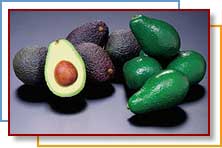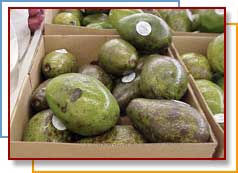
Avocados were first cultivated in South America with later migration to
Mexico. It was believed that a Mayan princess ate the very first avocado
and that it held mystical and magical powers. European sailors traveling
to the New World used avocados as their form of butter. Avocados were
first seen in the United States in the early 1800's. California is
currently the largest producer of avocados stateside. There are more than
80 varieties, with the "Hass" variety dominating the crop share.
A single mature avocado tree can produce more than 400 pieces of fruit in
a year.
|
| Avocados |
Serving size
1/2 cup, cubed (75g)
| Amounts
Per Serving |
% Daily
Value |
| Calories
120 |
|
| Calories
from Fat 100 |
|
| Total Fat
11g |
17% |
| Saturated
Fat 1.5g |
8% |
| Cholesterol
0mg |
0% |
| Sodium 5mg |
0% |
| Total
Carbohydrate6g |
2% |
|
Dietary Fiber 5g |
18% |
|
Sugars 0g |
|
| Protein 1g |
|
| Vitamin A |
2% |
| Vitamin C |
10% |
| Calcium |
0% |
| Iron |
2% |
* Percent Daily Values are based on a
2,000 calorie diet.
|
|
| |
|
Avocados are loaded with nutrients such as dietary fiber, vitamin B6,
vitamin C, vitamin E, potassium, magnesium, and folate. They're also
cholesterol and sodium free. Avocados contain 60% more potassium per ounce
than bananas. This fruit is an excellent source of monounsaturated
fat.
- Look for firm avocados if you're planning on using them later in the
week, otherwise, select fruit that yields to gentle pressure for
immediate use.
- Color alone will not tell you if the avocado is ripe. Ripe fruit
will be slightly firm, but will yield to gentle pressure.
- To speed the ripening process, place the avocado in a paper bag, and
store at room temperature until ready to eat (usually two to five
days). Placing an apple together with the avocado speeds up the
process even more.
- Cut the avocado in half, slightly twist the two halves, separate,
and remove the seed. Starting at the small end and remove the skin
with a knife, or, if you prefer, you can also scoop the flesh out with
a spoon.
- To retain a fresh green color, avocados should either be eaten
immediately or should be sprinkled with lemon or lime juice or white
vinegar.
There are several varieties of avocados and each have a unique flavor
and texture. Here are some of the most common avocado varieties in the
United States.
 |
Fuerte
This avocado is known for its thin smooth skin and creamy pale green
flesh. The skin remains green when ripe. It is available late fall
through spring. Considered a medium to large sized, pear shaped
fruit.
|
 |
Gwen
Considered a Hass to some folks, but really is a different kind of
avocado. With its medium to large oval shape and its thick pebbly
green skin, this avocado's skin remains green when it's ripe. Gwen
varieties are available late winter through late summer.
|
 |
Hass
The most common type of avocado in the United States is known for
its purplish black pebbly skin. The skin darkens when the fruit is
ripe and its flesh turns to a creamy pale green. This is the only
year round avocado.
|
 |
Pinkerton
This variety looks like a long pear with pebbly green skin. The skin
darkens when the fruit is ripe. The flesh is a creamy pale green
with a small seed. This avocado is available winter through spring.
|
 |
Reed
Also known as the Summertime variety avocado, it is a large round
fruit with thick green slightly rough skin. The skin stays green and
the flesh is a buttery yellow when the fruit is ripe. This fruit is
only available in the summer and early fall.
|
 |
Zutano
Available fall through early winter, this avocado is characterized
by its shiny, yellow green skin and pear shape. It is a large sized
fruit that stays the same color when ripe and has pale green flesh.
|
| Photos and variety
information courtesy of California Avocado Commission. |
Recipes

California Avocado Tacos
Serves 12.
Each serving equals 1/2 cup of fruit or vegetables
Source: California Avocado Commission
Ingredients
1 ripe California avocado, peeled and seeded
1 medium onion, julienned
2 large green peppers, julienned
2 large red peppers, julienned
1 cup fresh cilantro, finely chopped
1½ cups fresh tomato salsa (see below)
12 flour tortillas
non-stick cooking spray
Fresh Tomato Salsa
1 cup tomatoes, diced
1/3 cup onions, diced
½ clove garlic, minced
2 tsp cilantro
1/3 tsp jalapeño peppers, chopped
½ tsp lime, juiced
pinch of cumin
Spray skillet with cooking spray. Lightly sautè onion and green and
red peppers.
Cut avocado into 12 slices. Warm tortillas in oven and fill with
peppers, onions, avocado slices and salsa. Fold tortillas and serve.
Salsa Preparation:
Mix together all ingredients and refrigerate in advance.
Nutrition information per serving (tacos with salsa): Calories 170, Fat
6g, Calories from Fat 4%, Cholesterol 3mg, Sodium 167 mg.

Find more in our
recipe database!
|



